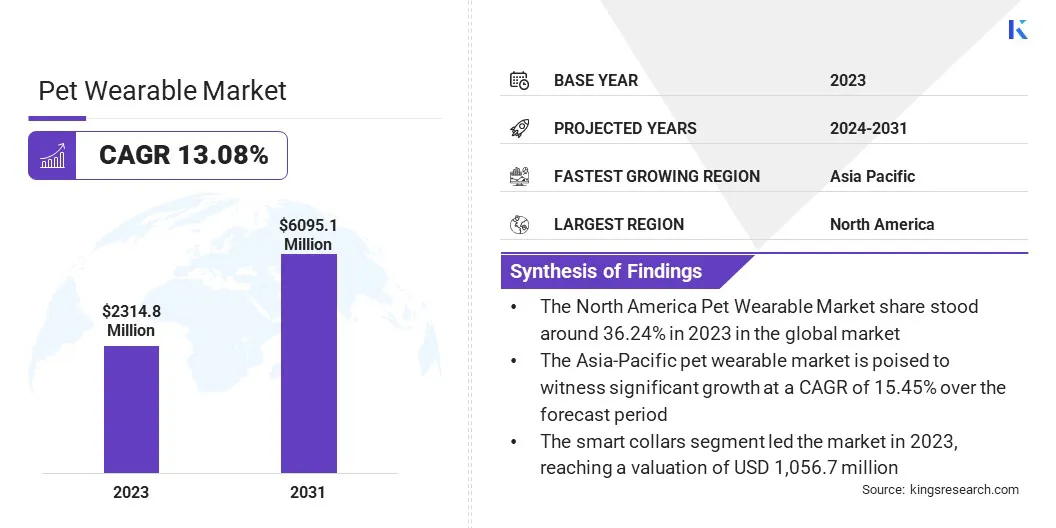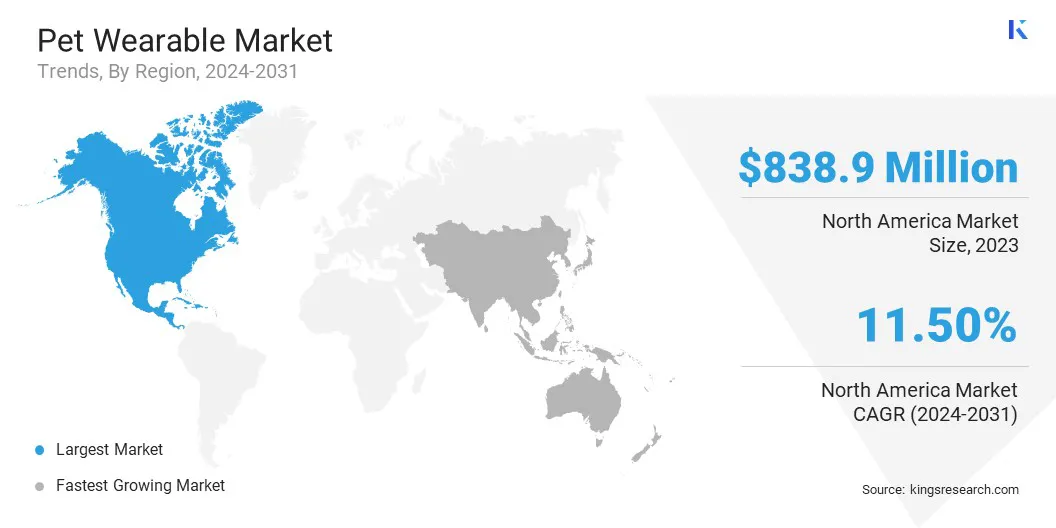Pet Wearable Market Size
The Global Pet Wearable Market size was valued at USD 2,314.8 million in 2023 and is projected to reach USD 6,095.1 million by 2031, growing at a CAGR of 13.08% from 2024 to 2031. The pet wearable market includes devices designed for pets, providing specialized services such as location tracking, health monitoring, and behavior analysis. These gadgets utilize technologies such as GPS, biometrics, and mobile apps to keep pet owners informed and engaged in their pets' well-being, thereby enhancing both safety and health management.
The growth of the market is driven by increasing pet ownership, particularly among millennials, and rising awareness of pet health needs. Technological advancements have enabled more sophisticated features in wearables, such as real-time health tracking and GPS location monitoring.
The expansion of the market is further supported by higher consumer spending on pet care and integration with smart home devices. Although the pet wearable market holds significant potential, it faces challenges related to privacy concerns regarding data collection and the high costs associated with advanced devices.
Addressing these issues involves enhancing data security measures and exploring cost-reduction strategies in manufacturing and supply chain management. Furthermore, the advancement of technologies that enable owners to be actively participate in their pets' health and well-being is projected to drive market growth over the forecast period.

Analyst’s Review
The pet wearable market is witnessing robust growth, mainly fueled by advancements in technology and a growing focus on pet health and overall well-being. These devices offer various functionalities, making pet monitoring easier and more convenient for owners. The market is expected to grow further as opportunities for new product development and optimization arise from the integration of AI and data analytics, resulting in the development of better products.
Pet Wearable Market Growth Factors
Technological advancements continuously impact the pet wearable market. Innovations such as precise location tracking via GPS, biometric monitoring of vital signs, and mobile connectivity for real-time updates are transforming the interactions between pet owners and these devices.
Developers are integrating AI to analyze pet behavior and health trends, offering preventative care solutions that appeal to proactive pet owners. This evolution in technology increases the functionality of pet wearables and enhances their appeal by making them essential tools for comprehensive pet management.
Pet ownership is on the rise, particularly among younger demographics, notably millennials who express a strong inclination toward adopting pets as part of their families. There is a notable increase in consumer spending on pet care products. The rise in disposable incomes is leading to greater willingness among pet owners to invest in advanced health and safety products for their pets. This trend is fostering an increased demand for pet wearables that offer convenience through features enabling constant monitoring and access.
Pet Wearable Market Trends
The widespread adoption of smart home technologies has created opportunities for integrating pet wearables with these systems. This integration enables pet owners to monitor and interact with their pets remotely through various devices such as smartphones and voice assistants.
For instance, cameras embedded in pet wearables can stream live video to smartphone apps, allowing owners to remotely monitor their pets. This connectivity extends to automatic feeders, pet doors, and environmental monitoring, all of which can be controlled via smart home platforms, thereby enhancing the convenience and security of pet care.
The growing emphasis on mental health and behavior modification is a significant trend impacting the pet wearable market. The development of devices designed specifically to monitor stress and anxiety levels in pets is gaining popularity. Furthermore, wearables equipped with sensors that detect changes in heart rate variability and activity levels provide owners with accurate information about their pets' distress levels.
Additionally, some devices offer features such as calming vibrations or sounds to alleviate stress in pets during distressing situations. This trend reflects a deeper understanding of pet well-being, highlighting the market’s potential beyond physical health monitoring.
Segmentation Analysis
The global pet wearable market is segmented based on product type, component, application, and geography.
By Product Type
Based on product type, the market is segmented into smart collars, smart harnesses, interactive feeders, and others. The smart collars segment led the market in 2023, reaching a valuation of USD 1,056.7 million due to its multifunctionality.
Advancements in technology have enabled the integration of services such as GPS tracking, activity monitoring, and health data collection in a single device. This helps alleviate pet owners’ concerns regarding the safety, fitness, and well-being of their animal companions. Additionally, ongoing feedback and optimization efforts are steadily enhancing accuracy and reliability, thereby boosting appeal among pet owners.
By Component
Based on component, the market is bifurcated into GPS chips, RFID chips, batteries, and others. The GPS chips segment secured the largest revenue share of 40.85% in 2023. This notable growth is fueled by their crucial role in enabling real-time location tracking.
This technology helps pet owners locate their pets if they stray. Advancements in the tech industry have resulted in the reduction of sizes, improvements in battery life, and data accuracy, making GPS chips the preferred choice for ensuring pet security and safety.
Pet Wearable Market Regional Analysis
Based on region, the global pet wearable market is classified into North America, Europe, Asia-Pacific, MEA, and Latin America.

The North America Pet Wearable Market share stood around 36.24% in 2023 in the global market, with a valuation of USD 838.9 million. The strong emphasis on pet health and safety contributes to the increasing demand for wearable technologies enabling continuous monitoring. Furthermore, North America boasts a robust technology infrastructure, along with rising consumer awareness regarding the exploration and adoption of innovative products, thus fueling the growth of the regional market.
The Asia-Pacific pet wearable market is poised to witness significant growth at a CAGR of 15.45% over the forecast period. The rising pet ownership rates in the region are expected to propel market growth over the estimated period (2024-2031).
The economies within the region are experiencing strong growth, leading to increased disposable incomes among its citizens. As urbanization and lifestyle changes continue, there is a growing focus on pet health and safety, which is expected to stimulate the demand for pet wearable products.
Furthermore, advancements in technology and enhanced manufacturing capabilities, particularly in countries such as China and India, are facilitating greater availability of pet wearables,. This trend is anticipated to bolster the growth trajectory of the regional market.
Competitive Landscape
The global pet wearable market report will provide valuable insight with an emphasis on the fragmented nature of the industry. Prominent players are focusing on several key business strategies such as partnerships, mergers and acquisitions, product innovations, and joint ventures to expand their product portfolio and increase their market shares across different regions.
Strategic initiatives, including investments in R&D activities, the establishment of new manufacturing facilities, and supply chain optimization, could create new opportunities for market growth.
List of Key Companies in Pet Wearable Market
- Tractive
- PetPace
- FitBark
- Science & Diagnostics
- Radio Systems Corporation
- Loc8tor Ltd.
- DOGTRA
- Mobiusworks Private Limited
- Barking Labs
- PETFON
Key Industry Developments
- March 2024 (Launch): PetPace introduced PetPace 2.0, a smart dog collar integrating AI capabilities to provide pet owners with real-time health insights, GPS tracking, and remote monitoring. The device monitors vital signs such as temperature, pulse, and behavior, featuring a patent-pending pain indicator and offering wellness assessments. It utilizes non-invasive sensors to ensure accurate health data without the risks associated with irradiation.
The Global Pet Wearable Market is Segmented as:
By Product Type
- Smart Collars
- Smart Harnesses
- Interactive Feeders
- Others
By Component
- GPS Chips
- RFID Chips
- Batteries
- Others
By Application
- Identification and Tracking
- Monitoring and Control
- Facilitation and Safety
- Others
By Region
- North America
- Europe
- France
- U.K.
- Spain
- Germany
- Italy
- Russia
- Rest of Europe
- Asia-Pacific
- China
- Japan
- India
- South Korea
- Rest of Asia-Pacific
- Middle East & Africa
- GCC
- North Africa
- South Africa
- Rest of Middle East & Africa
- Latin America
- Brazil
- Argentina
- Rest of Latin America


